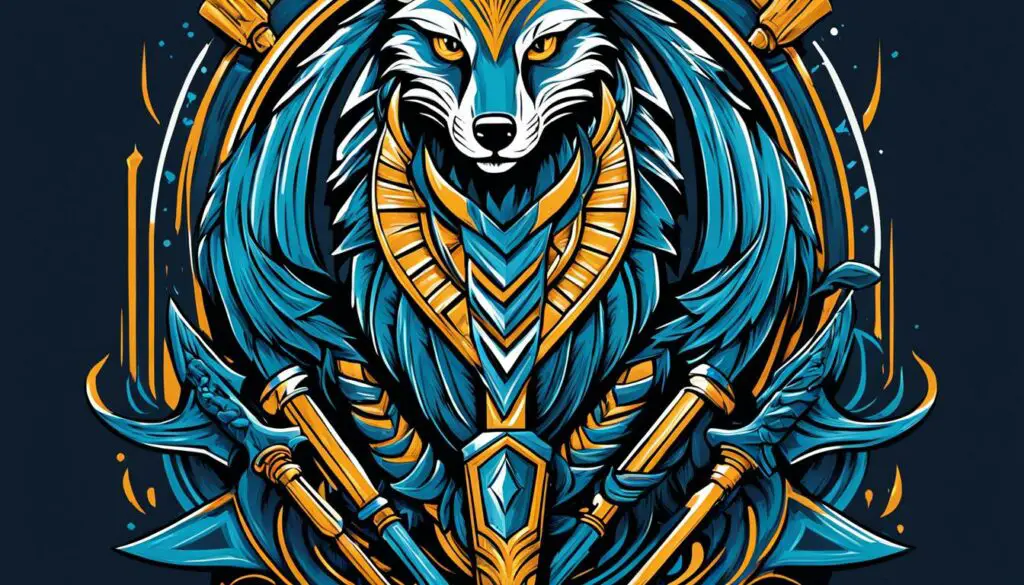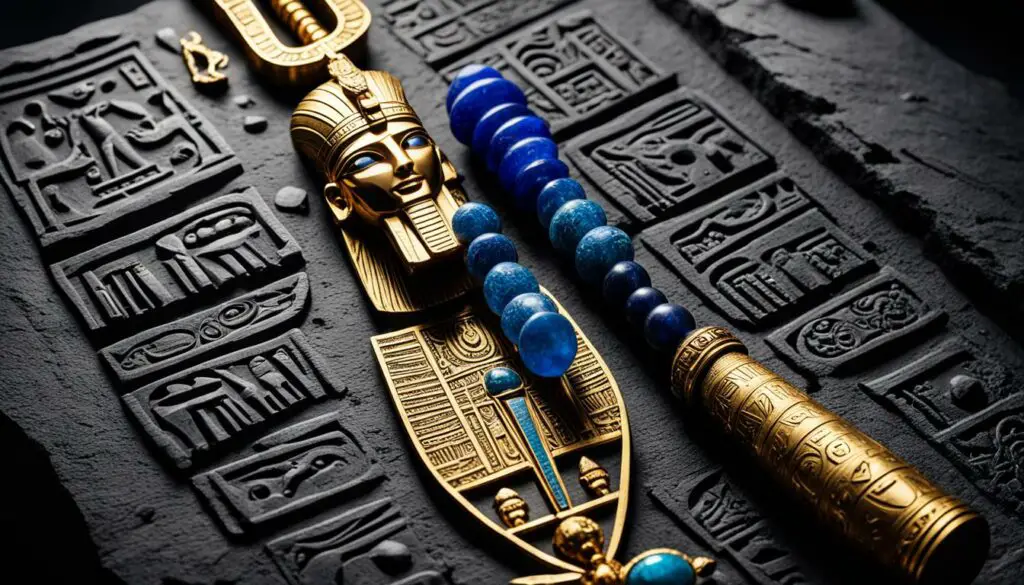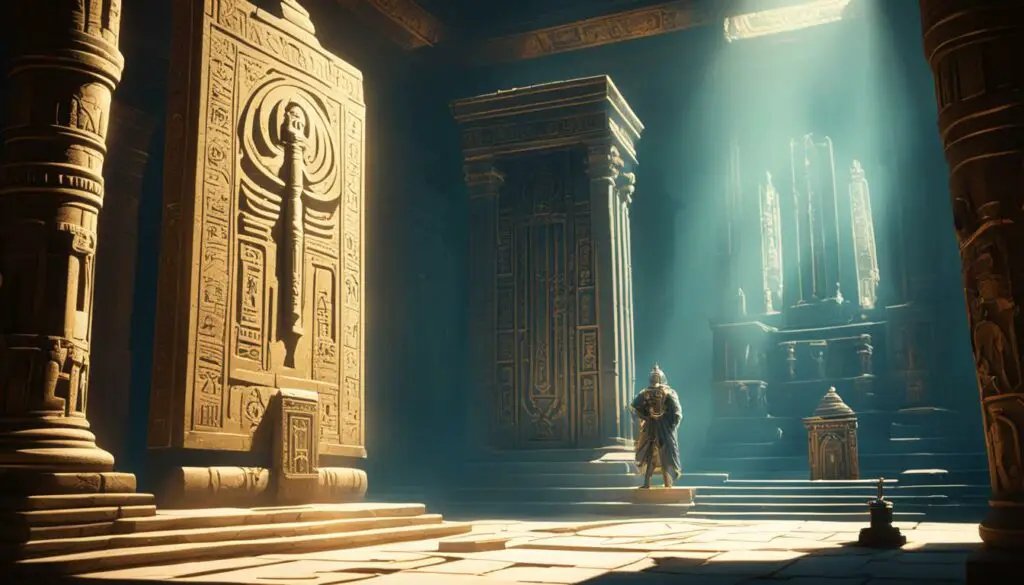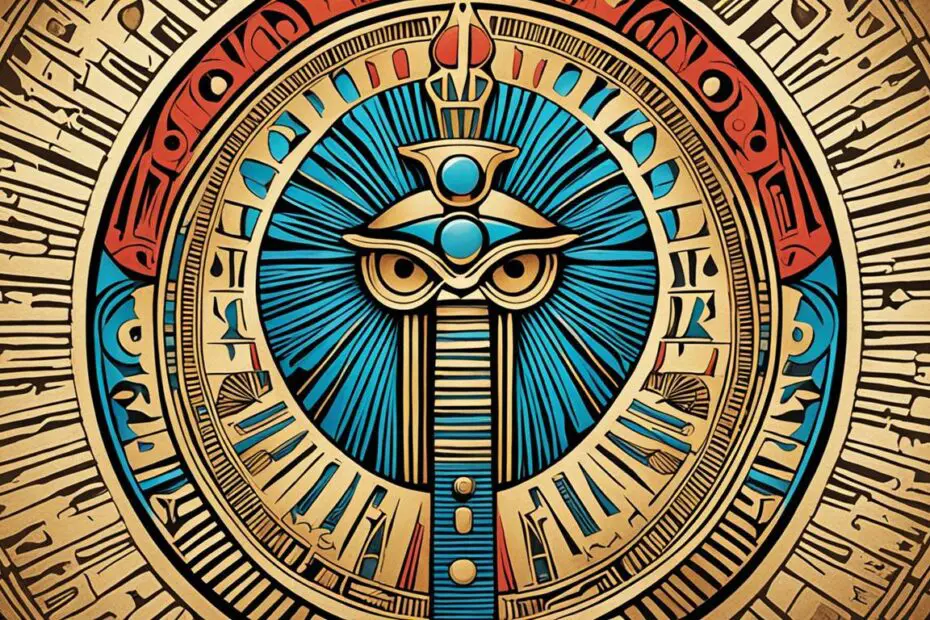The Was Scepter, one of the most intriguing ancient Egyptian symbols, has fascinated scholars and historians for centuries. Its significance in Egyptian culture is undeniable, especially in relation to the pharaohs. The meaning and symbolism behind the Was Scepter remain shrouded in mystery, leaving many unanswered questions.
Throughout this article, we will delve into the history, symbolism, and significance of the Was Scepter, aiming to unravel its enigmatic nature. Join us on this journey as we explore the ancient Egyptian symbols, their hidden meanings, and their impact on ancient civilizations. Let us embark on a quest to decipher the true essence of the Was Scepter and its role in Egyptian culture and society.
The History of the Was Scepter
The Was Scepter, a prominent religious artifact associated with Egyptian pharaohs, traces its origins back to ancient Egypt. This symbolic object, often depicted as a long staff with a curved top, held immense significance in Egyptian culture. Adorned with precious gemstones and intricate carvings, the Was Scepter represented power and authority, making it a staple in various ceremonial rituals.
Believed to have been used as a symbol of divine authority, the Was Scepter played a central role in religious practices of ancient Egypt. Its association with the pharaohs further enhanced its religious and ceremonial significance. The scepter’s intricate design and embellishments reflected the grandeur and prestige of the pharaoh’s rule.
Throughout history, the Was Scepter remained an enduring symbol of the pharaoh’s power and connection to the divine. Its presence in ancient Egyptian art and hieroglyphics provides valuable insights into the religious and cultural beliefs of the time. This religious artifact serves as a testament to the reverence and admiration the ancient Egyptians bestowed upon their pharaohs.
The history of the Was Scepter stands as a testament to the rich cultural heritage of ancient Egypt. This remarkable artifact continues to captivate modern-day scholars and historians, inspiring ongoing research and exploration into the religious practices of the ancient Egyptian civilization.
The Symbolism of the Was Scepter
The Was Scepter held deep symbolism in ancient Egyptian beliefs. It was believed to represent power, protection, and divine authority. The curved top of the scepter was often associated with the head of a deity and was believed to channel their power. It served as a symbol of the pharaoh’s ability to rule and protect his kingdom.

Ancient Egyptians believed that the Was Scepter had the power to ward off evil and protect their kings from harm. It was seen as a physical representation of the pharaoh’s divine protection and his connection to the gods. The scepter’s distinctive shape, resembling a shepherd’s crook, also symbolized the pharaoh’s role as the shepherd of his people, guiding and protecting them.
The Was Scepter was often depicted in hieroglyphs and artwork, emphasizing its importance in Egyptian culture. It was frequently portrayed in the hands of pharaohs during key ceremonies and rituals, signifying their authority and ability to govern with the support of the gods. This regal symbol served as a reminder of the pharaoh’s responsibility to uphold order and justice in the kingdom.
The symbolism of the Was Scepter extended beyond the earthly realm. It was believed to hold power in the afterlife as well, serving as a symbol of the pharaoh’s eternal rule and protection in the divine realm. Its presence in tombs and burial chambers emphasized the pharaoh’s connection to the gods and his immortality.
Symbolism of the Was Scepter in Ancient Egyptian Beliefs
The Was Scepter’s symbolism can be further understood by examining its various elements:
| Element | Symbolism |
|---|---|
| Curved Top | Represented the head of a deity and their divine power |
| Long Staff | Signified authority and protection |
| Precious Gemstones | Emphasized the regal nature of the scepter and its association with wealth and prosperity |
| Intricate Carvings | Contained sacred symbols and representations of deities, further enhancing its spiritual significance |
The symbolism of the Was Scepter is a testament to the ancient Egyptians’ beliefs and their reverence for power, protection, and authority. It continues to fascinate and captivate us today, reminding us of the rich symbolism embedded in the ancient world.
The Significance of the Was Scepter
The Was Scepter held great significance in ancient Egyptian royalty. It was revered as a symbol of the pharaoh’s divine connection and authority. Carried by the pharaoh during religious ceremonies and rituals, the Was Scepter represented his power and ability to rule over the kingdom.
But the significance of the Was Scepter extended beyond the earthly realm. It was believed to have a connection to the afterlife, serving as a tool for the pharaoh to maintain his power in the divine realm. The pharaoh’s possession of the Was Scepter ensured his influence and authority even in the realm of the gods.
This image depicts an intricately designed Was Scepter, showcasing the craftsmanship and importance placed on these symbols of power. The alt attribute of this image emphasizes the keyword “connection to the afterlife”.
The Ancient Egyptian Artifacts
Throughout history, various ancient Egyptian artifacts have been discovered, showcasing the rich cultural heritage of this ancient civilization. These artifacts offer a window into the lives, beliefs, and achievements of the people who lived in ancient Egypt. Among these remarkable treasures is the legendary “Scepter of Arcanum,” a captivating artifact that continues to mystify researchers and historians.
The Scepter of Arcanum is an extraordinary staff adorned with exquisite precious gemstones and intricate carvings. This ancient artifact is said to possess extraordinary powers, granting its wielder the ability to control the elements and unlock unimaginable abilities. Its awe-inspiring craftsmanship and intriguing symbolism make it a subject of fascination for scholars and enthusiasts alike.

Despite extensive study and research, the true purpose and origin of the Scepter of Arcanum remain shrouded in mystery. Scholars have delved into ancient texts and deciphered cryptic symbols in an attempt to unravel the secrets held within this enigmatic artifact. However, many questions still linger, leaving room for speculation and endless exploration.
The discovery of the Scepter of Arcanum highlights the enduring allure of ancient Egyptian artifacts. These relics offer valuable insights into the artistic, religious, and cultural practices of a civilization that thrived thousands of years ago. They serve as tangible connections to the past, transporting us to an era filled with wonder and mystique.
As researchers continue to uncover new artifacts and delve deeper into the mysteries of ancient Egypt, the story of these ancient Egyptian artifacts and their significance will evolve. The Scepter of Arcanum stands as a testament to the enduring power of these artifacts to captivate our collective imagination and invite us on a journey of discovery.
The Search for the Was Scepter
Many expeditions have been launched in search of the Was Scepter and other artifacts linked to ancient Egyptian symbols. These expeditions involve extensive research, analyzing ancient texts, and deciphering cryptic clues. They also require physical exploration of remote locations and dangerous environments in the hopes of uncovering the hidden secrets of the Was Scepter.
Explorers and archaeologists venture into the depths of Egypt, following the trail of ancient writings and legends that hold the key to the location of the elusive scepter. Deciphering the ancient texts is no easy task, as they are encoded with intricate symbols and hieroglyphics that have long faded from human memory.
The journey begins in the quiet corners of dusty libraries, as researchers meticulously pore over ancient scrolls and manuscripts, searching for clues and hidden meanings. These texts offer glimpses into the rituals, ceremonies, and beliefs of the ancient Egyptians, providing valuable insights into the significance of the Was Scepter.
Armed with this knowledge, expeditions set forth, traversing treacherous terrains, and searching through ancient ruins. They face harsh climates, unforgiving landscapes, and the ever-present threat of ancient curses. These brave adventurers believe in the power of the Was Scepter and the secrets it holds, fueling their determination.
The Power of Ancient Knowledge
The quest for the Was Scepter is not merely an adventure; it is a quest for ancient wisdom. The deciphering of ancient texts grants access to the knowledge and practices of a bygone era. It allows researchers to piece together fragments of history, gaining a deeper understanding of the ancient Egyptians and their beliefs.
These expeditions represent a tireless pursuit to uncover the mysteries of the past, to grasp the significance of the Was Scepter in the context of ancient Egyptian society. Each step forward brings them closer to unlocking the secrets that have been concealed for centuries.
Their efforts are driven by the belief that the Was Scepter holds the key to unlocking extraordinary powers and unraveling the enigmatic nature of ancient Egyptian civilization. It is a testament to humanity’s unending thirst for knowledge, the pursuit of which drives us to explore the unknown and unravel the mysteries of the past.
Unveiling the Mysteries of the Was Scepter
While the mysteries of the Was Scepter are still largely unsolved, there have been several breakthroughs in research that shed light on its enigmatic past. Fragments of ancient manuscripts, such as the “Codex of Arcanum,” have provided insights into the advanced knowledge possessed by the ancient Egyptians. These manuscripts contain instructions for harnessing the power of energy crystals, which were believed to be a significant source of power for the Arcanians.

| Breakthroughs in Research | Implications |
|---|---|
| Ancient Manuscripts | Reveal insights into advanced knowledge and practices of the ancient Egyptians |
| Codex of Arcanum | Contains instructions for harnessing the power of energy crystals |
| Energy Crystals | Believed to be a significant source of power for the Arcanians |
The Quest for Evidence
The search for concrete evidence of the Was Scepter and its connection to ancient Egyptian civilization continues. Archaeologists and historians are constantly on the lookout for artifacts and inscriptions that could provide valuable insights into the true nature and significance of the Was Scepter. These discoveries could help unravel the mysteries surrounding this ancient symbol.
Artifacts Unearthed
Over the years, numerous artifacts related to the Was Scepter have been unearthed in archaeological excavations across Egypt. These artifacts include intricately carved scepters, hieroglyphic inscriptions, and depictions of pharaohs wielding the scepter in temple reliefs.
One notable artifact is the Scepter of Thutmose III, which was discovered in the funerary temple of the pharaoh in the ancient city of Thebes. This beautifully crafted gold and lapis lazuli scepter serves as a physical testament to the power and importance of the Was Scepter in ancient Egyptian society.
Inscriptions and Texts
Ancient Egyptian hieroglyphic inscriptions and texts hold valuable clues about the significance of the Was Scepter. Inscriptions found in tombs, temples, and papyrus scrolls provide descriptions and explanations of the role of the scepter in religious rituals and its connection to the afterlife.
The Book of the Dead, a collection of ancient Egyptian funerary texts, mentions the Was Scepter as a symbol of power and protection for the deceased. This suggests that the scepter held immense importance in enabling the pharaoh to navigate the realm of the gods and ensure a successful journey into the afterlife.
Scientific Analysis
Modern scientific techniques have also played a crucial role in uncovering evidence related to the Was Scepter. Carbon dating, chemical analysis, and microscopic examination of artifacts provide valuable insights into their age, composition, and craftsmanship.
The Analysis of Gemstones from Was Scepters has revealed the use of precious materials such as gold, lapis lazuli, and carnelian. These findings not only shed light on the artistic skill of ancient Egyptian craftsmen but also indicate the high value attributed to the Was Scepter.
| Artifact | Location | Description |
|---|---|---|
| Scepter of Thutmose III | Thebes, Egypt | A gold and lapis lazuli scepter depicting intricate carvings. |
| Scepter of Hatshepsut | Deir el-Bahari, Egypt | A finely crafted limestone scepter found in the mortuary temple of Queen Hatshepsut. |
| Hieroglyphic Inscriptions | Various locations in Egypt | Writings and carvings that provide insights into the symbolism and significance of the Was Scepter. |
The Legacy of the Was Scepter
The legacy of the Was Scepter has left an indelible mark on Egyptian art and culture, permeating various aspects of ancient civilization. This iconic symbol of power and authority has influenced the artistic expressions of the time, shaping the visual identity of Egypt’s artistic endeavors.
The Was Scepter’s prominence in Egyptian art can be observed in its recurring presence in sculptures, paintings, and hieroglyphs. The depictions often showcase pharaohs wielding the scepter, emphasizing their divine connection and rule over the kingdom. This artistic representation solidified the Was Scepter’s role as a symbol of unyielding power and authority.
Moreover, the influence of the Was Scepter extended beyond individual artistic depictions. It served as a catalyst for the development of architectural motifs and designs. The distinct shape and symbolism of the scepter found its way into temple structures, palace facades, and tomb decorations. By incorporating the Was Scepter into their architecture, the ancient Egyptians sought to imbue their creations with an aura of authority, as well as a direct connection to the divine.
Was Scepter Influence on Egyptian Art and Culture
| Art Form | Description |
|---|---|
| Sculpture | Statues and reliefs depicting pharaohs holding the Was Scepter as a symbol of their divine authority. |
| Painting | Inclusion of the Was Scepter in mural scenes and tomb paintings, highlighting the pharaoh’s power and role as a divine ruler. |
| Hieroglyphs | Incorporation of the Was Scepter as a hieroglyphic symbol representing power, authority, and the divine connection of the pharaoh. |
| Architecture | Integration of the distinctive shape and symbolism of the Was Scepter into temple facades, palace entrances, and tomb decorations. |
The Was Scepter’s lasting influence on Egyptian art and culture is a testament to its significance in the ancient civilization. This enduring legacy serves as a reminder of the power and authority attributed to the pharaohs and their divine connection, immortalized through the art forms of the time.
The Was Scepter in Modern Times
The enigmatic allure of the Was Scepter transcends the boundaries of time, captivating the imagination of people in modern culture. With its deep-rooted association with ancient Egyptian symbols and the intriguing mysteries that shroud its origin, the Was Scepter continues to fascinate and enthrall.
In popular culture, the symbol of the Was Scepter finds its place in various mediums, including books, movies, and artwork. It serves as a powerful emblem, evoking a sense of reverence for the ancient world and its rich symbolism.
Whether portrayed in historical novels transporting readers to the grandeur of ancient Egypt or depicted on the silver screen in epic movies, the Was Scepter symbolizes the enduring fascination with ancient symbols and the mysticism surrounding them.
Ancient Inspirations in Modern Art
The fascination with ancient symbols like the Was Scepter can be seen in contemporary artwork. Artists around the world draw inspiration from the mystique of ancient civilizations, infusing their creations with elements of ancient Egyptian culture.
Paintings, sculptures, and mixed media works often incorporate the distinct shape and symbolism of the Was Scepter, paying homage to the profound influence of ancient Egypt on modern artistic expression. These captivating artworks serve as a visual link between the past and the present, reminding us of the enduring legacy of ancient symbols.
The Symbolic Significance
Beyond its representation in popular culture and modern art, the fascination with ancient symbols like the Was Scepter stems from their deep symbolic significance. These symbols carry the weight of history, connecting us to the beliefs, traditions, and achievements of our ancestors.
The Was Scepter symbolizes power, authority, and the long-lasting impact of pharaohs in ancient Egyptian society. Its presence in modern times serves as a reminder of the timeless fascination with ancient civilizations and the desire to unravel their mysteries.
| Was Scepter in Modern Culture | Fascination with Ancient Symbols |
|---|---|
| The Was Scepter is a prominent symbol in books, movies, and artwork. | Ancient symbols like the Was Scepter continue to captivate and inspire. |
| The symbol represents the enduring fascination with ancient Egypt and its culture. | Ancient symbols hold a profound allure, evoking a sense of mystery and wonder. |
| Depictions of the Was Scepter serve as a visual link to the mysteries of the past. | Ancient symbols carry the weight of history, connecting us to our heritage. |
The Quest for Knowledge
The quest for knowledge about the Was Scepter and ancient Egyptian symbols is an ongoing endeavor. Researchers, archaeologists, and historians continue to dedicate their efforts to uncovering the hidden secrets of these artifacts. Through ongoing research and exploration, they strive to unlock the ancient secrets that lie within these enigmatic symbols.
Ongoing Research
The ongoing research surrounding the Was Scepter and other ancient Egyptian symbols is essential for expanding our understanding of ancient civilizations. Researchers analyze historical records, study artifacts, and decipher ancient texts to gain insights into the cultural, religious, and symbolic practices of ancient Egyptians.
Unveiling Ancient Secrets
As researchers delve deeper into the mysteries surrounding the Was Scepter, they hope to unveil ancient secrets that have been hidden for centuries. By examining the intricate details of these artifacts and consulting various sources, they aim to shed light on the symbolism, significance, and purpose of the Was Scepter in ancient Egyptian society.

Exploring the Ancient Mysteries
Delving deeper into the ancient mysteries of the was scepter takes us on a captivating journey of discovery and exploration. Through the meticulous study of artifacts, the deciphering of ancient texts, and the unraveling of the symbol’s symbolism and significance, we unlock profound insights into the beliefs and achievements of ancient civilizations.
As we explore these mysteries, our understanding of the past expands, allowing us to appreciate the rich history of humanity in a profound way. The was scepter, with its enigmatic allure, serves as a gateway to the ancient world, granting us a glimpse into the minds and experiences of those who came before us.
By peering into the depths of the artifacts and texts associated with the was scepter, we uncover the secrets that have remained hidden for centuries. This quest for knowledge not only fuels our curiosity but also contributes to the preservation of our cultural heritage. It is through the exploration of these ancient mysteries that we can connect with our shared human history and gain a deeper appreciation for the remarkable achievements of our ancestors.
FAQ
Q: What is the significance of the Was Scepter in ancient Egyptian culture?
A: The Was Scepter symbolizes power, protection, and divine authority in Egyptian culture. It is associated with the pharaoh’s ability to rule and protect his kingdom.
Q: What does the Was Scepter look like?
A: The Was Scepter is a long staff with a curved top. It is often adorned with precious gemstones and intricate carvings.
Q: What is the history of the Was Scepter?
A: The Was Scepter originated in ancient Egypt. It was used as a religious artifact and commonly associated with Egyptian pharaohs.
Q: What role did the Was Scepter play in ancient Egyptian rituals?
A: The Was Scepter played a crucial role in religious ceremonies and rituals. It was often carried by the pharaoh as a symbol of his power and authority.
Q: Is there any connection between the Was Scepter and the afterlife?
A: Yes, the Was Scepter was believed to have a connection to the afterlife. It was seen as a tool for the pharaoh to maintain his power in the divine realm.
Q: Have any artifacts linked to the Was Scepter been discovered?
A: Yes, the “Scepter of Arcanum” is an artifact believed to be linked to the Was Scepter. It is adorned with precious gemstones and intricate carvings.
Q: What efforts have been made to uncover the secrets of the Was Scepter?
A: Many expeditions have been launched to search for the Was Scepter and other artifacts. These expeditions involve research, analysis of ancient texts, and exploration of remote locations.
Q: Have there been any breakthroughs in research related to the Was Scepter?
A: Yes, there have been breakthroughs in research that have provided insights into the enigmatic past of the Was Scepter. Fragments of ancient manuscripts, such as the “Codex of Arcanum,” have contributed to this research.
Q: Is there any concrete evidence of the Was Scepter and its connection to ancient Egyptian civilization?
A: Researchers and historians are constantly on the lookout for artifacts and inscriptions that could provide evidence of the Was Scepter and its significance. These discoveries could help unravel the mysteries surrounding this ancient symbol.
Q: How has the Was Scepter influenced Egyptian art and culture?
A: The Was Scepter’s symbolism and significance have influenced various aspects of Egyptian civilization, from art and architecture to religious beliefs and rituals.
Q: Does the Was Scepter still hold relevance in modern times?
A: Yes, the Was Scepter continues to captivate the imagination of people in modern times. Its association with ancient Egyptian culture and its mysteries have sparked fascination and intrigue, leading to its presence in popular culture.
Q: What is the ongoing quest for knowledge regarding the Was Scepter?
A: Researchers, archaeologists, and historians continue to dedicate their efforts to uncovering the hidden secrets of the Was Scepter. Their work helps us gain a deeper understanding of ancient civilizations and their cultural, religious, and symbolic practices.
Q: What can we learn from exploring the mysteries of the Was Scepter?
A: By studying the artifacts, deciphering ancient texts, and unraveling the symbolism and significance of the Was Scepter, we gain insights into the beliefs and achievements of ancient civilizations. The exploration of these mysteries broadens our knowledge and deepens our appreciation for the rich history of humanity.
